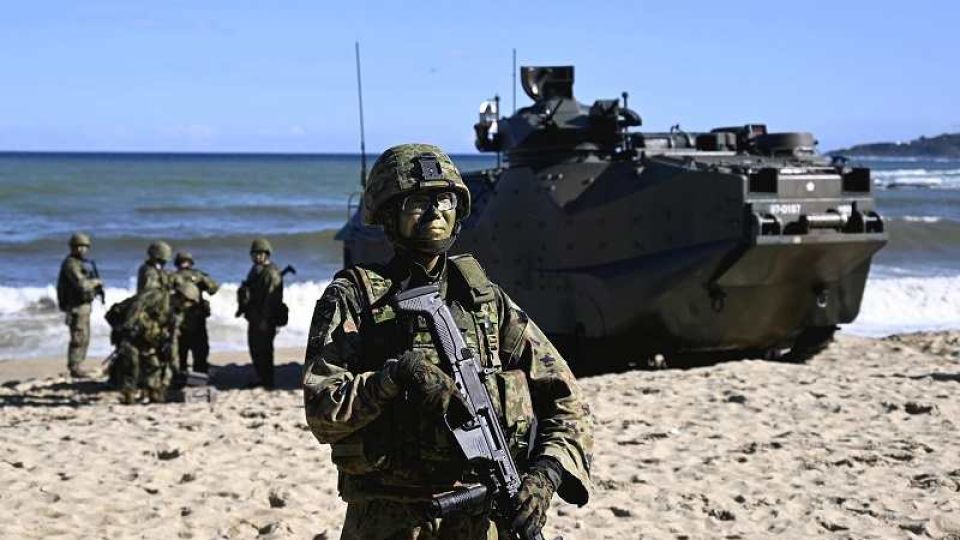November 21, 2022
TOKYO – Japan and the United States have wrapped up their largest joint military exercise, Keen Sword, amid an unprecedented sense of urgency, as the possibility of a real Taiwan crisis has come to the fore. The drills, conducted in the Nansei Islands, stretched from the southern tip of Kyushu to Okinawa Prefecture and included other areas.
The Self-Defense Forces are hurrying to identify lessons learned from the latest 10-day drill that concluded Saturday.
Considering that a Taiwan contingency could spread to the Nansei Islands, the Defense Ministry believes that conducting large-scale exercises in the areas will itself serve as a deterrent.
On a sandy beach of Tokunoshima Island, Kagoshima Prefecture, SDF personnel carefully checked to make sure there were no enemies in the area and waved toward the sea to signal that a landing was possible.
With the public invited to watch, the SDF conducted a training exercise to retake an occupied remote island on Friday. As part of the drill, personnel in black wetsuits had secretly infiltrated the island.
The OK sign to land was communicated to the MSDF transport vessel Osumi and the U.S. Navy’s amphibious transport dock ship New Orleans, both of which were standing by a dozen kilometers offshore. The two vessels deployed 14 amphibious vehicles, which proceeded toward the island. Just before the vehicles reached the shore, a curtain of smoke was created to blind the enemy while the landing troops rushed to take control of the entire beach.
Hundreds of local residents gathered on the beach to watch the drill.
The exercise on Tokunoshima Island was joined by Osprey transport aircraft from Japan and the U.S. This was the first exercise involving such aircraft in the Nansei Islands.
A Type 16 maneuver combat vehicle (MCV) with powerful 105mm cannons was also deployed on the island. An MCV was also dispatched to Yonaguni Island, Okinawa Prefecture, Japan’s westernmost island, for the first time.
In the event of a Taiwan emergency, there are concerns about a severe impact on the island, which is only 110 kilometers from Taiwan.
The MCV is considered a key piece of equipment in the defense of remote islands because, unlike tanks, it runs on tires and can travel at speeds of about 100 kph. Moreover, the vehicle can be transported by aircraft as it is lighter than a tank. The Defense Ministry plans to procure a total of 134 vehicles of this type by next fiscal year.
On Thursday, an MCV was brought to Yonaguni Airport by a C-2 transport aircraft and ran about 6 kilometers on civilian roads to Camp Yonaguni.
“We were cautious about the timing of dispatching the MCV, so as not to provoke a backlash from residents,” said an SDF senior official. “We had to confirm the vehicle’s mobile deployment capabilities in order to respond to the worsening international situation.”
Sustainment ability

The Yomiuri Shimbun
A Type 16 maneuver combat vehicle drives on a civilian road to Camp Yonaguni on Yonaguni Island on Thursday.
The joint exercise Keen Sword has been held almost every two years since fiscal 1985. The latest event was the 16th and involved a total of 36,000 SDF and U.S. military personnel, 30 vessels and 370 aircraft. Tactical drills were conducted in various locations.
“We aim for practical training under the assumption of situations ranging from the gray zone [between peacetime and emergency] to armed attack,” Gen. Koji Yamazaki, chief of staff of the Self-Defense Forces’ Joint Staff, said at a press conference held Nov. 14.
As one of their priority areas, the SDF focused on improving sustainment, the ability to continue organized fighting in the event of an emergency. The SDF aims to strengthen capabilities that they lack, such as the ability to provide logistics and medical care to the wounded in addition to the transportation capability to send heavily equipped troops to such islands.
On Tuesday, they used Osprey aircraft in an exercise to transport injured Japanese and U.S. personnel to hospitals on Okinawa Island for treatment.
The city of Naha has a hospital run by the SDF, but it has only 50 beds. In order to expand its functions, a mobile medical system capable of performing surgeries was brought on site, and training was conducted to transfer the wounded who require more advanced treatment out of Okinawa by C-130 cargo planes.
The exercise also invited as observers military officers from the North Atlantic Treaty Organization, which has been strengthening its ties with Japan since Russia’s invasion of Ukraine. One of the officers expressed his appreciation for the Japan-U.S. close interoperability, and the view that this could be utilized in a multilateral framework in the future.

